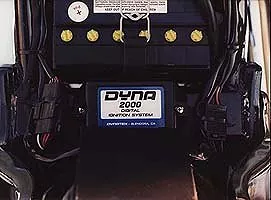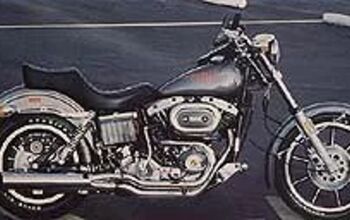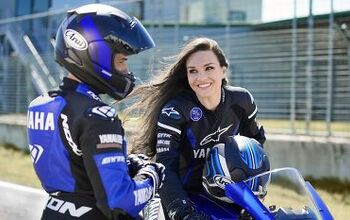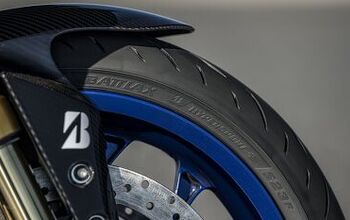Church Of MO: Dynatek Dyna 2000

ECU tuning isn't anything new.
Normally, Church of MO features are all about motorcycle reviews we've done from a time long, long ago. It's fun to take a trip back in time to see what we thought about yesteryear's motorcycles back when they were new. Today's Church feature is a little different. Today's motorcycles are basically sophisticated computers on two wheels. Making them go faster or perform better is less the result of turning a wrench, and more a product of pushing a button on a laptop. But tuning via computers instead of wrenches isn't a new concept. As proof, we take you back to the year 2000 and this ECU module to improve the performance of... a Harley-Davidson Dyna. Although the Dyna was carbureted, playing with spark and altering when the air/fuel ratio goes pop compared to what the factory says is still a staple of tuning today.
Dynatek Dyna 2000
by James Hawkins, Contributing Writer
March 9th, 2000
Straight from the box, Harley-Davidson's family of stallions sport a dual-fire ignition configuration. A single coil sends its blast through the gaps of both spark plugs on both compression and exhaust strokes, in what has often been termed a "wasted spark" setup. All these years Harley's faithful have been firing blanks.
Amongst the myriad of aftermarket catalogs for Harley's fleet that, piled up, far surpass the thickness of a New York City phone directory, resides a product line that will appeal to the musically inclined. We're not talking about exhaust systems this time. The buzz word here is single-fire.
My surgical candidate was a 1996 Harley FLSTF Fat Boy. For this operation, the Fat Boy had already done its first 3000 miles inhaling refreshing gulps of British Columbia coastal mist through a Dynojet carb kit, and Screamin' Eagle breather. Just what the doctor ordered. It had stopped bucking and spitting, and the prognosis was excellent. Its only other amenities were Bosch Platinum spark plugs and stock pipes with a 1/4 inch hole drilled in the baffle - just enough to make it sound proper.
Once I figured out how to remove the saddle without scratching anything, Dynatek's instruction package led me through the installation. It is a little bit of a challenge for those of us not versed in all things electrical, but a fun project for the curious.
Dynatek's microcomputer-controlled module plugs right into the stock box's harness on this bike, and because Dynatek's unit is the same size and shape, it uses the OEM screws to hold it in place. There are adapter harnesses available for other applications, if required.
Unlike H-D's original module, the Dyna 2000 has a row of DIP switches for programming four new rev limits of 6000, 6500, 7000, or 7500 rpm, and four separate advance curves to enhance performance. There is also your choice of single or dual-fire. An LED diagnostic light permits straightforward static timing for the initiated. Dynatek even charts the curves for you in the instructions, and recommends some appropriate settings. I clicked in the most aggressive curve, but picked the 6000 rev limit since the rigid-mounted mill is designed to vibrate the paint off the tank above three grand anyway. Appropriate energy levels are maintained through Digital Dwell Control at all rpm, and you can choose from a broad range of coils. Be sure to check the specs and/or consult someone regarding your choice.
I chose Dynatek's own twin coil DC6-3 package, since two coils are required for the single-fire application. Removing the original coil is easy, but installing the new ones takes some time as the best wiring route becomes an aesthetic journey in itself. After considerable tinkering, the Dynatek coils fit under the stock Harley chrome cover. It's a very tight fit, but Dyna has a new bracket to make this segment easier. There's even a tachometer output lead from the module for those who wish to fit a tach.
After the installation it's time for a test flight. The engine springs to life with just a light tap on the start button, and immediately settles to an even, staccato idle. It's obvious that a new conductor is directing this duet. Some of the minute peripheral vibration is noticeably absent, and the best word to describe my overall perception of the note, is cleaner. A more rounded, individual pair of thumps.
Pulling away in first gear, carburetion seems more closely connected to the twist grip. Throttle response is a level higher. Working up through the gears feels the same, but acceleration in top gear is different. In stock tune, the motor would seem to be succumbing to a mildly overbearing and retarding vibration. With the new ignition, acceleration uphill feels positively linear. The power doesn't want to bog down. More twist just gives more go with no complaints, backed up with a perfect bark. On the straight and level, rolling on in top gear brings the kind of acceleration that says this motor is happy. It just wants to go. What it really does for things like mileage and horsepower warrants further study.
This package would be a perfect capper to any other serious mechanical upgrades in a Big Twin. Dynatek gives you the option to switch back to dual-fire on the same module, but as far as I'm concerned, that's one little DIP switch that'll stay flicked to the single-fire side, thank you very much. Dynatek's Dyna 2000 HD1 Ignition Module retails for $224.99, while Dynatek DC6-3 Coils are priced at $132.99. Dynatek also has many other fine products to keep your electrons under precise control. Check them out
Become a Motorcycle.com insider. Get the latest motorcycle news first by subscribing to our newsletter here.

Troy's been riding motorcycles and writing about them since 2006, getting his start at Rider Magazine. From there, he moved to Sport Rider Magazine before finally landing at Motorcycle.com in 2011. A lifelong gearhead who didn't fully immerse himself in motorcycles until his teenage years, Troy's interests have always been in technology, performance, and going fast. Naturally, racing was the perfect avenue to combine all three. Troy has been racing nearly as long as he's been riding and has competed at the AMA national level. He's also won multiple club races throughout the country, culminating in a Utah Sport Bike Association championship in 2011. He has been invited as a guest instructor for the Yamaha Champions Riding School, and when he's not out riding, he's either wrenching on bikes or watching MotoGP.
More by Troy Siahaan































Comments
Join the conversation
A Fatboy isn’t a dyna. It was a soft tail model.
I don't see any evidence of John Burns.
Has he left? Is he well?
Thank you.